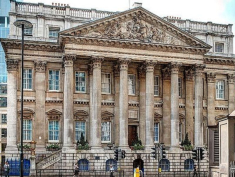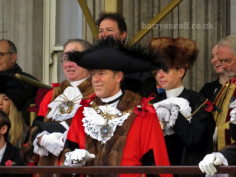





Docklands and the Thames,
Victoria Park to Paternoster
Square. Take a nostalgic
trip back to the East End in
the 1950’s or a stroll around
the Square Mile of the City
of London. It’s all here at
barryoneoff.co.uk
Copyright 2002 - 2024 ©Barry Carter. All rights reserved
THE WARDS, or Aldermanries, of the City
The Wards of the City of
London
The City of London is divided into twenty five different sections called Wards, or Aldermanries (26 before 1978). Each of these areas has its own Warden, or Alderman to take care of the administration and running of each section. The Wards were named as follows: Tower Street Ward Lime Street Ward Portsoken Ward (outside the walls) Basinghall Ward Aldgate Ward Langbourne Ward Broad Street Ward Cornhill Ward Bridge Ward (within) Candlewick Street Ward Billingsgate Ward Vintry Ward Walbrook Ward Dowgate Ward Coleman Street Ward Cheape Ward Cordwainer Street Ward Aldersgate Ward (within and without) Bishopsgate Ward (within and without) Cripplegate ward (within and without) Bread Street Ward Queenhithe Ward Castle Baynard Ward Farringdon Ward (without) Bridge Ward (without) Bridge Gate WardThe Aldermen
Twenty five of the City Aldermen are elected for a term of office which used to be their lifetime but now ends at the retiring age of a Magistrate. The twenty sixth Alderman (Bridge Gate Ward) must be a former Lord Mayor and must also have been a Sheriff of the City. This has come to be due to the change of City jurisdiction of the ward. Southwark formed the Bridge Ward Without (outside the walls). It was in ancient times, a part of the City. This is no longer the case but the old tradition carried on until 1978 when it was discontinued. The Aldermen also have the final vote on who is to be Lord Mayor of London for the coming year. The Livery men of the City elect two final candidates from the list of nominees, and the Aldermen choose from these.The Lord Mayor
The Lord Mayor is the most powerful man in the City of London. Only the reigning sovereign takes precedence over him. He resides at the Mansion House and his Household includes the Sword bearer, the Common Crier, and the Sergeant-at-Arms, the City Marshall. The first Mayor of London was Henry FitzAilwyn in 1192 or thereabouts. He held the post until his death in 1212 but in 1215 King John granted the charter allowing the annual election of a Mayor. The term "Lord" Mayor was first recorded in 1414. The Corporation of the City is the oldest governing body still in existence today, and the rights and privileges of the citizens were recognised by William I in his 1067 charter. William is not referred to as "the Conqueror" in the City because he never conquered it. Unlike the rest of the country he was allowed to negotiate. The "Lord Mayor" should not be confused with the Mayor of London. They are two separate entities.The Court of Common
Council
The Court of Common Council meets at the Guildhall every other Thursday. It dates back to the 13th. century and is presided over by the Lord Mayor. In his absence an Alderman who has previously served as Mayor presides. The opening words for each meeting are: “Domine dirige nos, Amen”. Which means Lord direct us. This is also the City Corporation motto on the coat of arms. From the 25 Aldermen of the City and 130 Common Councillors at least 2 Aldermen and 40 Councillors must be in attendance at the meetings. The Lord Mayor is accompanied by members of his Household Escort. There is also an assembly of Livery men who meet to elect the Sheriffs and Mayoral candidates. The public can attend these sessions, which are basically council meetings to discuss the running of the square mile. There are also monthly meetings held in the Great Hall of the GuildhallElecting Councillors
Elections are unique because as well as City residents, businesses can also appoint workers for City Ward Elections. To qualify for the office of Common Councilman a person must at the date of nomination and at the date of election be: Aged 18 years or over and a British subject or a citizen of the Republic of Ireland. They must also either (a) be registered on the City of London Ward Lists, or (b) own freehold or leasehold land in the City (if the land is leasehold and is held on a joint tenancy, the maximum number of joint tenants who can qualify is four) or (c) have resided in the City for 12 months preceding the date of nomination, and intends to reside here until the date of election They can be disqualified for any other reason, for example, by reason of bankruptcy or on conviction of fraud or any crime for which a prison sentence has been imposed. A person must also be a Freeman of the City of London, this can be granted quickly for potential candidates.


Inside the Mansion House (below).
















